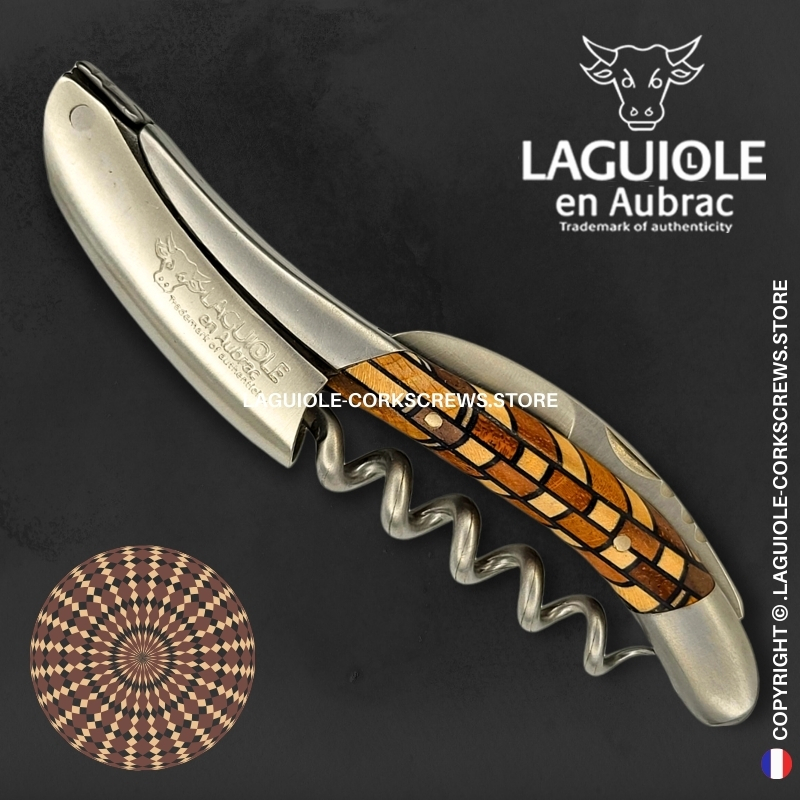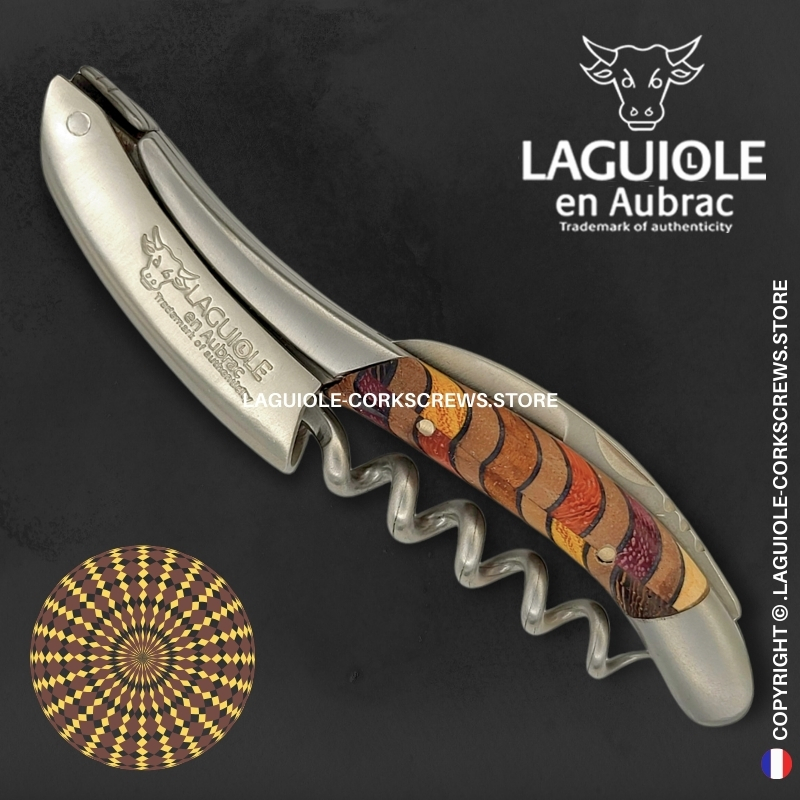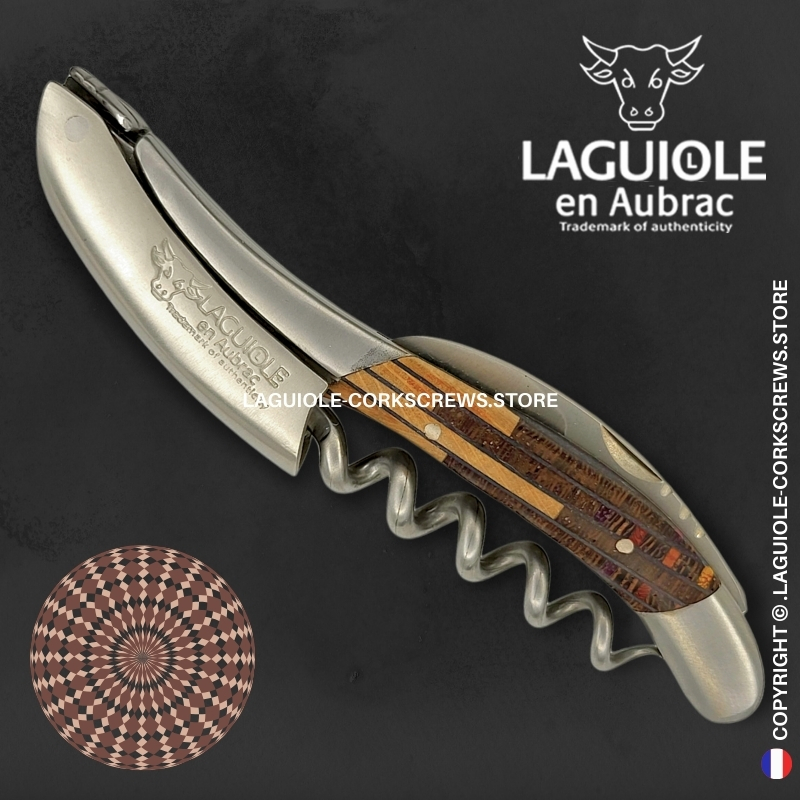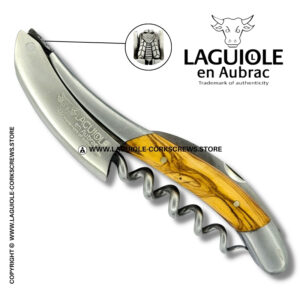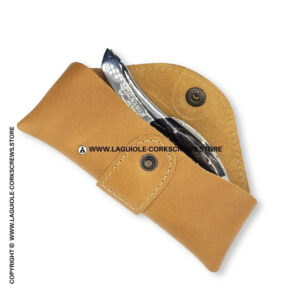Finish isn’t just about appearance — it’s about feel, presence, and how the material tells its story. Learn how to choose between mirror and satin polished Laguiole en Aubrac corkscrews.
Why Corkscrew Finish Matters
When choosing a Laguiole en Aubrac corkscrew, most buyers focus on the handle material — olivewood, buffalo horn, or rare stabilised burl. But the polish finish applied to the metal components is just as essential. It influences not only the tool’s appearance but also how it complements the natural beauty of the materials used. Mirror-polished or satin-finished, each choice tells a different story and serves a specific purpose in design and function.
Mirror Polished: Radiance and Contrast
The mirror-polished finish is a high-gloss surface applied to the stainless steel parts of the corkscrew — typically the lever, the bolsters, and sometimes the foil cutter. Achieved through meticulous buffing and polishing, this finish reflects light like a mirror and adds a luxurious brilliance to the tool.
Mirror polish is ideal for dark materials like ebony, snakewood, and black horn. The bright gleam of the steel creates a striking contrast, highlighting the depth and richness of the natural material. This type of finish is often chosen for display pieces, engraved gifts, or ceremonial use, where the corkscrew is both tool and showcase item.
However, it also requires slightly more care. Fingerprints and fine scratches may show more easily than on satin finishes, meaning a gentle wipe with a cloth is recommended after each use.
Satin Polished: Subtlety and Texture
Satin polishing offers a soft matte sheen that diffuses light instead of reflecting it. Created through controlled brushing and sanding, this finish feels refined and understated. It is appreciated by professionals and users who value elegance without ostentation.
Satin-finished metal pairs especially well with lighter or textured woods like olivewood, pistachio wood, or juniper. It lets the natural patterns of the material remain the focal point, rather than competing for attention. In the hand, it also provides a slightly less slippery feel, ideal for sommeliers who use their corkscrew daily.
Its low-maintenance nature — less prone to smudges or minor wear marks — makes it a favourite for those who seek durability and function over flash.

Finish and the Material it Highlights
In Laguiole en Aubrac’s design process, the finish is never chosen at random. It is selected to enhance the natural character of each handle. For example:
- Mirror polish draws attention to grainless or dark materials (like buffalo horn or polished black ebony) by creating visual contrast.
- Satin finish softens the transition between warm, veined woods and steel, like pistachio or olivewood, for a harmonious result.
- Some collectors choose mirror-finished models specifically for engraving, as the polish makes inscriptions more legible and luminous.
Understanding this dynamic allows buyers to select a model that feels balanced, intentional, and truly reflective of their style.
→ Engraved Laguiole Corkscrews
Visual Impact and Symbolism
The finish also plays a symbolic role in gift-giving. Mirror polish can be interpreted as celebratory and festive, suitable for milestone events or collector’s items. Satin, meanwhile, is reserved and timeless, suggesting a daily companion — a reliable, professional tool with quiet elegance.
This is particularly relevant when selecting a Laguiole corkscrew for occasions like weddings, anniversaries, or retirements. The finish becomes part of the message the object conveys.
Mirror vs Satin: At a Glance
| Feature | Mirror Finish | Satin Finish |
|---|---|---|
| Surface | Glossy, reflective | Matte, brushed |
| Material pairing | Dark, polished materials | Light, textured woods |
| Visual effect | Striking, luxurious | Subtle, warm |
| Fingerprints | More visible | Less visible |
| Maintenance | Requires occasional polishing | Low-maintenance |
| Popular uses | Display, gifts, collectors | Professional use, daily tool |
Which Should You Choose?
There is no wrong choice — only the one that suits your taste, usage, and the message you want to send. Ask yourself:
- Will this corkscrew be used daily or occasionally?
- Do I prefer shine and contrast or softness and warmth?
- Am I pairing this with a particular type of wood or horn?
- Is this a gift? If so, what kind of impression do I want to leave?
Answering these questions helps narrow your choice — and ensures your Laguiole corkscrew feels like it was made just for you.
A Note on Craftsmanship
Whether mirror or satin, each finish is applied by hand in the Laguiole en Aubrac workshop in southern France. It is not a factory coating — it is a physical gesture of polishing, brushing, and inspecting. The finish you select is the result of artisan work, adjusted millimeter by millimeter to create a unified object of balance and beauty.
Combined with hand-fitted blades, forged worms, and natural materials, this polish contributes to the final harmony of the corkscrew — function meeting finesse.
Conclusion: Finish as a Final Signature
In a Laguiole en Aubrac corkscrew, every element matters. The finish is not an afterthought — it’s a final signature that defines the piece’s attitude. Mirror polish dazzles. Satin polish reassures. Both are expressions of tradition, taste, and timeless elegance.

